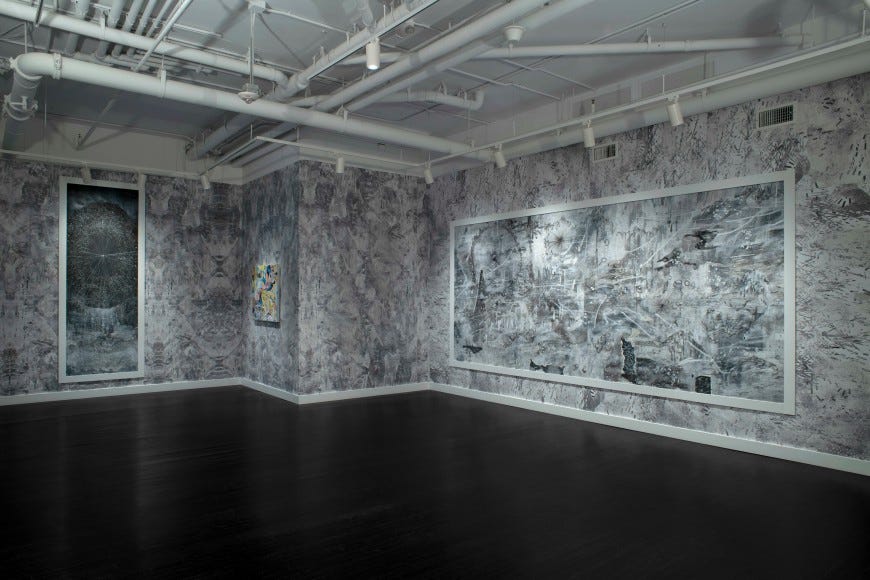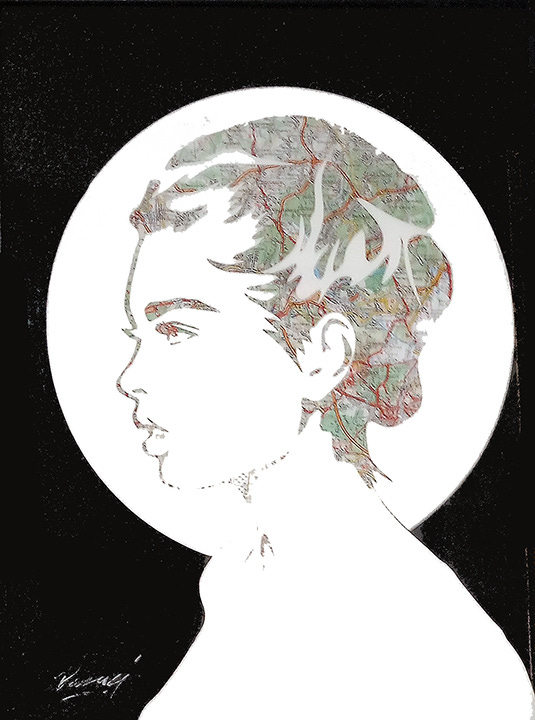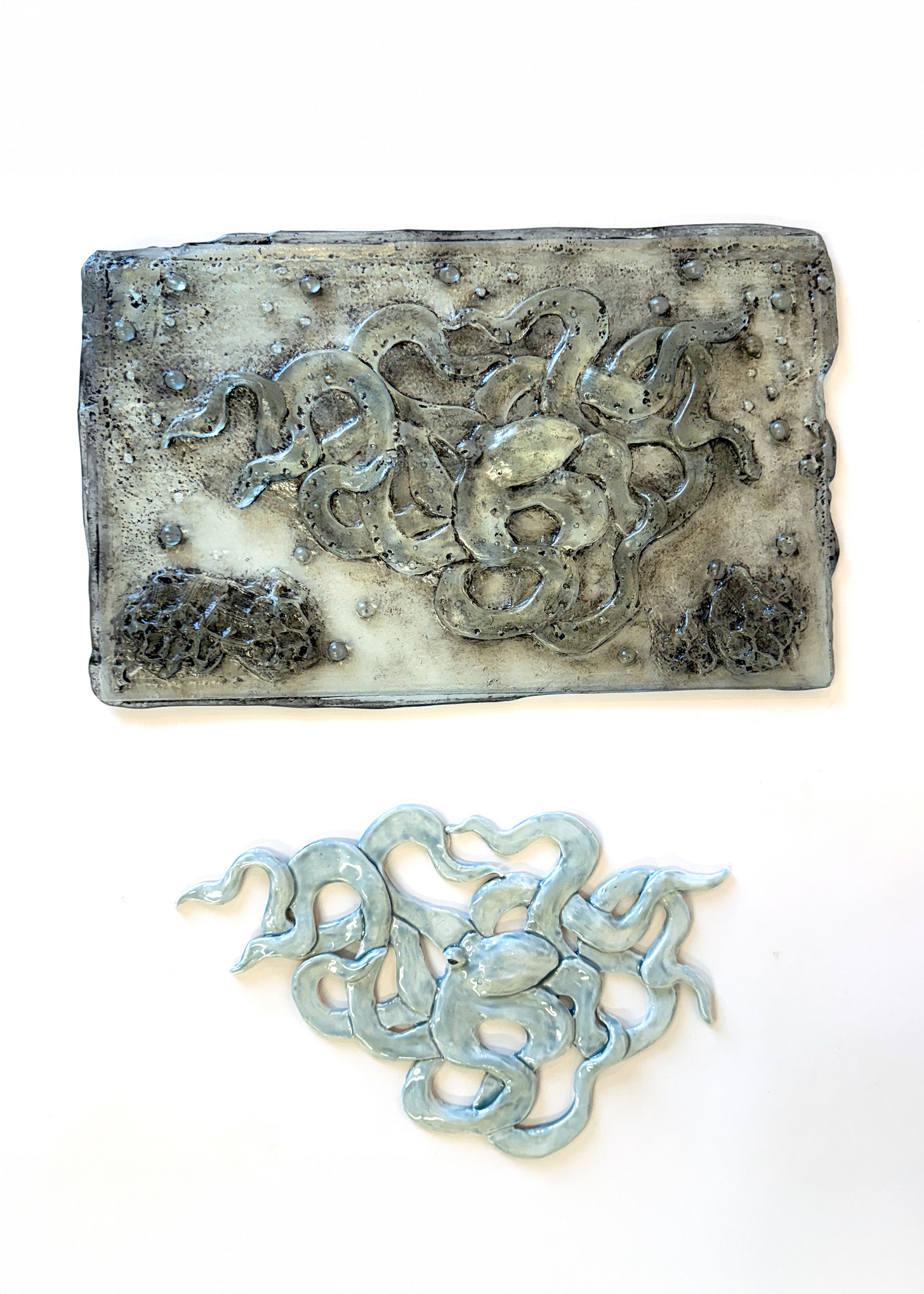Off the Map
Amy Schissel and Joanathan Bessaci's cartographical concoctions; Laurel Lukaszewski and Hannelie Coetzee's multiple and mutable ways of looking at animals
Installation view of "Amy Schissel" (Hemphill Artworks)
OF THE TWO VARIETIES OF PICTURES IN AMY SCHISSEL'S Hemphill Artworks show, one clearly dominates. That's not just because nine of the 14 abstractions are in (mostly) bluish black-and-white, and only five in full color. It's also due to the fact that the (nearly) monochromatic drawings surge off the paper and onto the walls, entirely covering a large corner of the rear gallery. These sprawling temporary murals dwarf Hemphill visitors as well as the three drawings or paintings, one of them in color, hung atop them.
The gallery's statement playfully likens Schissel's creations to "the imaginary maps at the beginning of fantasy novels," yet these kinetic pictures chart nothing but themselves. Some of the drawings do include barely discernible features such as red triangles or bars, which could be read as homages to -- or parodies of -- the symbols deployed in actual maps. But the Florida-based Canadian artist offers no legend to explain these icons, and the tiny crimson marks don't seem to indicate anything fixed in place. Rather, the emblems appear to be in continual flux.
That's a quality they share with the other pictorial elements. Whether working in color or (mostly) black-and-white, Schissel conjures paroxysms of motion. Often her apparently improvisational compositions appear to emanate from a central point, in the manner of a big bang. Even when the artworks are actually or seemingly pieced together, the action rockets toward the sides of the (sometimes rounded) frame.
Such titles as "Tracking and Spinning" and "Vector Vigor" suggest that this impression is intentional. Rather than locating places, Schissel evokes such transient events as mists, storms, and explosions. The paint, ink, graphite, and charcoal are permanently placed, but they evoke phenomena that last just an instant.
Joanathan Bessaci, “Halo 2” (Zenith Gallery)
IF JOANATHAN BESSACI'S ARTWORKS ARE MORE LITERALLY MAP-LIKE than Schissel's, that's largely because actual maps are among his raw materials. The French-born D.C. artist's grandfather sold old maps at a Lyon flea market, and both French and American ones feature in "Mapping the Soul," Bessaci's Zenith Gallery show. They're the basis for multi-ply collages that chart the body, and perhaps the soul.
A contemporary map of central Washington underlies a cut-out portrait of Abraham Lincoln whose famous features hover above roads and bridges the former president wouldn't recognize. (George Washington also appears, but painted on cardboard rather than collaged, and part of a series that also includes Jean-Michel Basquiat.) More complicated, and intriguing, are several anatomy lessons in which tangles of red highways suggest the human circulatory system. Some of these collages are full-bodied, while others depict simply the brain, traversed by synapses that are actually French roadways.
In the striking "Halo 2," a woman's face is an expanse of white whose hair, features, and profile are defined by cuts that reveal a map beneath the surface. As in all of Bessaci's cut-and-collaged pieces, parts of the lower levels are tantalizingly unseeable, evoking submerged thoughts and emotions.
The artist's other way of working with paper and cardboard is to make painted sculptures, mostly wall-mounted renderings of animal heads. A gorilla, a Doberman, an eagle, and a paper-fringed tiger jut from the wall. If these are less distinctive than the map-based collages, they're equally cogent at demonstrating Bessaci's flair for transforming flat scraps of paper into artworks of manifold depth.
Laurel Lukazewski, "Submerged Duo" (Artists & Makers)
THE METHODS ARE INTENTIONALLY MORE DIVERSE THAN THE THEMES in Laurel Lukaszewski's masterly Artists & Makers exhibition, "Reiterations: A Material Exploration." A virtuoso ceramicist, the Mount Rainier-based artist recently added glass to her repertoire. She's constructed glass relief sculptures of some of her customary subjects, and used both glass and wooden matrixes to make prints. The result is a show that consists primarily of multiple-media renderings of four creatures: rabbits, octopi, ravens, and cicadas.
Lukaszewski often groups together identical or similar images in different formats: stoneware, woodcut prints, and glass wall sculptures, alongside the wood, porcelain, or glass forms from which the prints were made. There's a satisfying tension between repetition and variation, especially since all the artworks are essentially black and white. The hues that could be termed "white," however, include ivory, tan, clear, and greenish translucent glass. The latter is sometimes daubed discreetly with black paint, mirroring the ink of the prints.
The artist once lived in Japan and has a long involvement in cross-cultural programs involving that country and the U.S. The Japanese influence is evident in the titles and subjects of several pieces, including ones that portray rabbits engaged in otsukimi ("moon-viewing") or pounding rice flour into mochi. The latter scene is depicted in prints made from ceramic and wooden masters, both round. (Moon shaped?) Yet Lukaszewski doesn't merely repeat traditional Japanese motifs. Many of these creatures have specific meaning to her, and all are rendered with a personal touch. That gives these repeated, subtly varied forms a strong sense of individuality.
Hannelie Coetzee, "Baboonish Hyenas I-IV (Quad)" (Morton Fine Art)
FREE-FLOWING PIGMENT CORRELATES WITH ANIMAL LOCOMOTION in Hannelie Coetzee's painterly ink-and-watercolor drawings. The South African artist's Morton Fine Art show, "Eco Queer Creatures," depicts hyenas, zebras, giraffes, and wildebeest in states of coming and going, appearing and dissolving. This mutability reflects Coetzee's view that -- according to the gallery's statement -- "queerness is not unnatural" in the natural world.
The artist's pictures are mostly in watery black, with touches of hyena- or fox-toned brown. From a distance, the images can evoke inkblots. This is especially true of the earliest pieces, two compositionally mirrored 2017 watercolors. These light-blue renderings were not merely inspired by grasses but actually include embossed stalks, which thrust upward as if reaching for sunlight.
Although her style is delicate and her colors thin, Coetzee has strategies for adding depth. Some of the pictures are, as in her previous Morton Fine Art show, splayed across sheets from an old mining-company ledger. An expansive series of "Urban Foxes" -- inspired by ones seen in London -- gambol across pages from an antique travel book.
This show also encompasses almost-silhouetted penguins whose black surfaces have been scratched to render subtly the skeletons that support their fluid forms. The tiny incisions are as close as the artist gets to scientific illustration, but even the penguins are primarily impressionistic. Coetzee's subjects swoop by unexpectedly, and don't wait around to be dissected.
Amy Schissel
Through June 21 at Hemphill Artworks, 434 K St. NW. hemphillartworks.com. 202- 234-5601.
Joanathan Bessaci: Mapping the Soul
Through July 5 at Zenith Gallery, 1429 Iris St. NW. zenithgallery.com. 202-783-2963.
Laurel Lukaszewski: Reiterations: A Material Exploration
Through June 25 at Artists & Makers, 11810 Parklawn Dr., Rockville. artistsandmakersstudios.com. 240-437-9573.
Hannelie Coetzee: Eco Queer Creatures
Through June 24 at Morton Fine Art, 52 O St. NW, #302. mortonfineart.com 202- 628-2787. Open by appointment.




